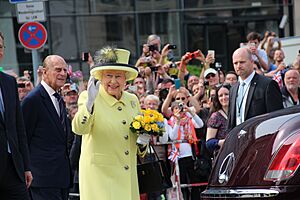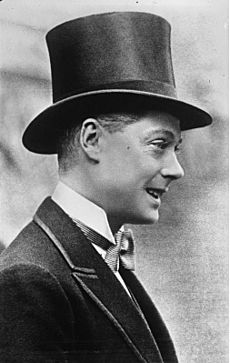Royal Succession Bills and Acts facts for kids
Royal Succession Bills and Acts are special laws or proposed laws in the United Kingdom. They decide who gets to be the next King or Queen of the UK.
A Succession to the Crown Bill is a suggested law. It can be put forward by a private Member of Parliament or by the Government. These bills aim to change the rules about who inherits the throne. They are discussed in either the House of Commons or the House of Lords.
The Crown is a legal idea. It means the government's power, not a physical crown. It's how the country's property and power are kept separate from the King or Queen's personal things.
A bill is like a draft law. It's not a real law until it's approved by the parliament and the King or Queen. Once approved, it becomes an "Act" or "statute."
Contents
Understanding Succession Laws
Many Bills and Acts have been used over time to decide who would be the next King or Queen. This was especially important when different royal families took the throne. For example, when the Tudors, Stuarts, Hanoverians, and Saxe-Coburg and Gotha changed to the current Windsors.
These laws often changed older rules to fit new situations. Important historical acts include the Bill of Rights 1688, the Act of Settlement 1700, and the Royal Marriages Act 1772. The Regency Act 1937 was passed after King Edward VIII gave up his throne. This law helped his brother, Albert (who became King George VI), become the new monarch. Later, King George VI's daughter, Queen Elizabeth II, became Queen in 1952.
How a Bill Becomes a Law
Before a bill is officially introduced, a special committee might look at it. This committee, made of members from both Houses, reviews the bill. They can suggest changes. The government can choose to accept or reject these suggestions.
![]() First Reading: The bill is formally introduced. No vote happens yet. It's just printed, and a date is set for its next step.
First Reading: The bill is formally introduced. No vote happens yet. It's just printed, and a date is set for its next step.
![]() Second Reading: Members of Parliament debate the main ideas of the bill. After the discussion, they vote on whether to continue with the bill.
Second Reading: Members of Parliament debate the main ideas of the bill. After the discussion, they vote on whether to continue with the bill.
Committee Stage: A smaller group of MPs or Lords looks at the bill in detail. They go through each part and can suggest changes or "amendments."
Report Stage: The whole House gets another chance to suggest changes to the bill. They look at the parts that were changed in the committee.
![]() Third Reading: This is a final debate on the bill's finished text. In the House of Lords, more changes can still be made here.
Third Reading: This is a final debate on the bill's finished text. In the House of Lords, more changes can still be made here.
Passage to the Other House: Once one House approves the bill, it goes to the other House. For example, if it starts in the Commons, it then goes to the Lords.
![]() First Reading: The same steps happen in the second House.
First Reading: The same steps happen in the second House.
![]() Second Reading: The second House debates and votes on the bill.
Second Reading: The second House debates and votes on the bill.
Committee Stage: A committee in the second House reviews the bill.
Report Stage: The second House can suggest more changes.
![]() Third Reading: A final debate in the second House.
Third Reading: A final debate in the second House.
Return to Original House: If the second House makes changes, the bill goes back to the first House. Both Houses must agree on the final version.
Royal Assent: Finally, the bill is sent to the King or Queen for approval. If they agree, the bill officially becomes an Act of Parliament, which means it is now a law!
Recent Succession Laws
Queen Elizabeth II's Time
The Succession to the Crown Act 2013 is a key law from recent times. It changed the rules for who inherits the British throne. This law was passed in 2013.
It came about after an agreement called the Perth Agreement. In 2011, leaders from 16 countries that share Queen Elizabeth II as their head of state met in Perth, Australia. They agreed to change the old rules. The main goal was to stop male children from having priority over female children in the line of succession.
The old law was seen as unfair to women and Catholics. The government wanted to end this discrimination. Many attempts by individual Members of Parliament to change the law had failed. So, the government decided to bring forward its own bill.
To change the law, the UK government needed permission from the other 15 Commonwealth countries that have the Queen as their head of state. They all agreed. Changing these old laws also brought up questions about the Church of England and the union between England and Scotland.
Government Bill that became law:
| Rt Hon Nick Clegg MP Liberal Democrats Cabinet Office |
Succession to the Crown Act 2013 Presented in the Commons during the Conservative (Coalition) Government of PM David Cameron. |
Royal assent on 25-04-2013 |
This law changed who could inherit the Crown and rules about royal marriages. |
Past Succession Laws
King Henry VIII
King Henry VIII had several wives, which caused many problems for who would inherit the throne. Because of this, he created the First, Second, and Third Succession Acts.
When the Pope kicked Henry out of the church, Henry passed the Act of Supremacy in 1534. This law said that the King was the "only Supreme Head" of the Church of England. The Treasons Act 1534 made it a crime, punishable by death, to disagree with this.
|
This law made the children of King Henry VIII and Anne Boleyn the legal heirs to the English throne. It meant Princess Elizabeth (who later became Elizabeth I) was first in line. It also said that Princess Mary (who later became Mary I) was not a legitimate heir. People had to swear an oath to accept this law and the King's power over the church. If they refused, like Sir Thomas More, they could be charged with treason. The Second Act of Succession (1536) This law was passed after Anne Boleyn was executed. It removed both Mary and Elizabeth from the line of succession. This meant Henry had no legal child to inherit the throne until his son, Prince Edward, was born in 1537. The Third Act of Succession (1544) This law replaced the first two acts. It set the new line of succession. First, it was Prince Edward (who became Edward VI). Then, any children Henry might have with Katherine Parr. After that, it was Mary, and then Elizabeth. |
William and Mary
After a period of change, William III and Mary II became rulers in 1689. They agreed to a new law called the Bill of Rights 1688. This bill was very important because it limited the power of the King and Queen. It made Parliament more powerful than the monarch.
The Bill of Rights said that the King could not:
- Make or stop laws without Parliament's permission.
- Raise taxes on his own.
- Have a standing army during peacetime.
It also made sure Parliament met often and that members could speak freely during debates.
Another law, the Coronation Oath Act 1688, changed the oath the King or Queen took when they were crowned. The new oath made the monarch promise to rule according to the laws agreed upon by Parliament, not just their own will.
King Edward VIII
The His Majesty's Declaration of Abdication Act 1936 was a special law passed by the British Parliament. It officially recognized that King Edward VIII had given up his throne. He decided to abdicate so he could marry Wallis Simpson, a woman who had been divorced. The governments of the UK and other British Commonwealth countries did not approve of this marriage.
Even though Edward VIII signed a paper saying he would give up the throne on December 10, 1936, he was still King until this Act was approved. The Act was passed very quickly, in just one day, on December 11, 1936. It also made sure that any future children of Edward could not inherit the throne. After this, his brother, Prince Albert, Duke of York, became King George VI.
See also
- Line of succession to the British throne
- First Succession Act (Succession to the Crown Act 1533)
- Second Succession Act (Succession to the Crown: Marriage Act 1536)
- Third Succession Act (Succession to the Crown Act 1543)











